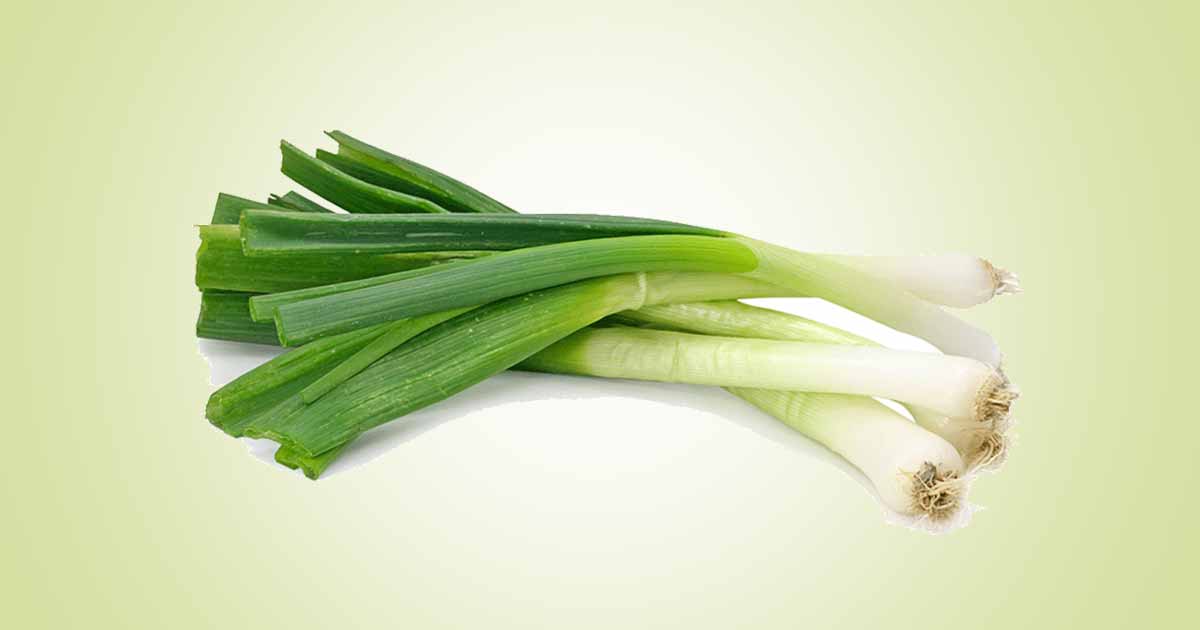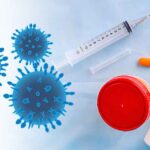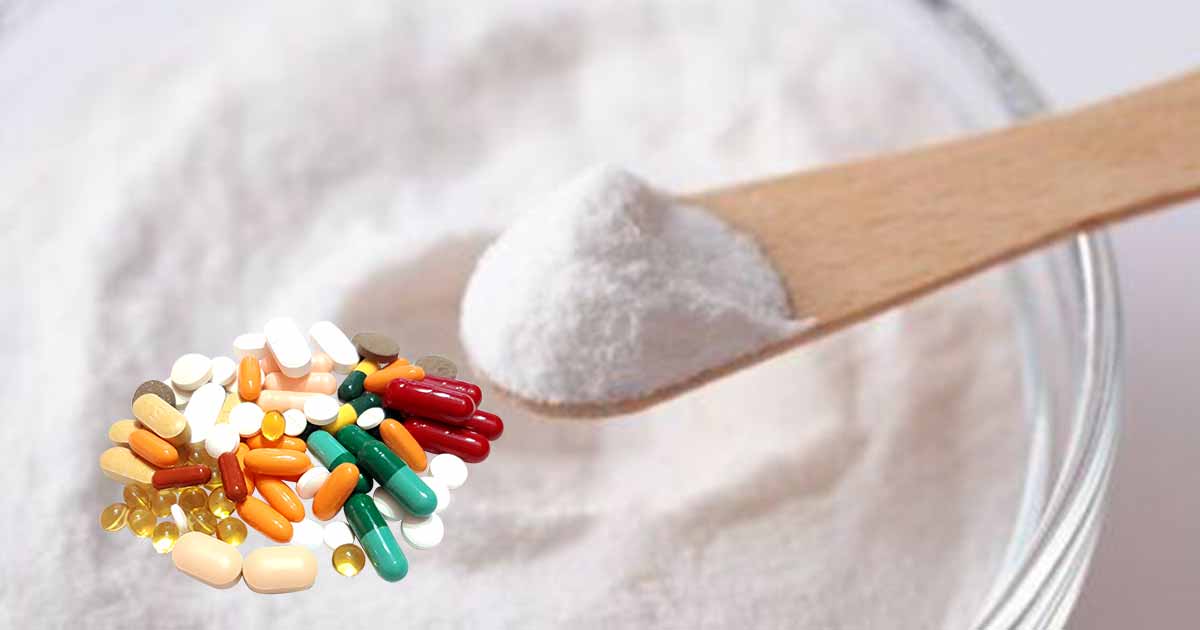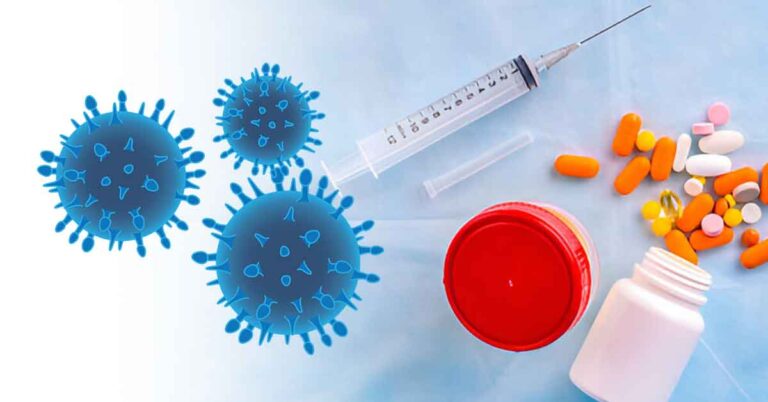Leek (Allium porrum), also called “the gourmet’s onion”, is a root vegetable related to onion, and garlic. It belongs to the lily family (Liliaceae) and the Allium genus, which contains up to 700 species utilized for their edible, medicinal, and ornamental benefits. All plants in the Allium genus are edible, herbaceous biennial plants grown as annual vegetables.
Other names of leek includes great round-headed garlic, perennial sweet leek.
Allium porrum looks like a large green onion with flat leaves. It is made of sheaths of basal leaves that can be 15–25 cm long and 5 cm in diameter. It is a tall, hardy, biennial with white, narrowly ovoid bulbs and broad leaves.
Leek has a long, white, thick, cylindrical stalk made of overlapping leaf bases and leaves. These overlapping leaf bases, which form the stalk.
The leaves are flat, green to blue-green, with fan-like arrangement, and normally bend down under their own weight about midway up the stalk. Leek can produce flower clusters from the second year. The flowers have six white, pink or purple leaves, six stamens and three ovaries.
Leek is not found in the wild, but originates from Alliumampeloprasum, a diverse species found in the Mediterranean region and the Near East. Leek is common in Europe than North America or Asia.
It is now grown in European countries like Turkey, France, Belgium, The Netherlands, Germany, Spain, UK and Bulgaria, tropical and subtropical regions including Egypt, India and Indonesia, and in the USA, Canada and Australia.
Leek is a vegetable for consumption and has the advantage of having more refined, subtle and sweet flavor than onions. It can be eaten raw in salads or deep-fried, steamed or stewed alone, or with other vegetables. Usually, only the white part of the plant is consumed.
Some important recipes made with leek include:
- Potato Leek Soup: Made with ingredients like chopped onions, dried rosemary, crushed garlic, medium potatoes, large leeks, coriander, bay leaves, vegetable stock/broth, can coconut cream, salt, and pepper.
- Leek & Cashew Appetizer: leeks, cloves of garlic, raw cashews, dried oregano, cayenne pepper, sea salt, and olive oil.
Leek seed has been utilized in traditional medicine to treat impotence, neuralgia, vitiligo, chronic diarrhea, freckle, hemoptysis, asthma, obesity, constipation, and hemorrhoids. It is also an appetizer and aphrodisiac.
Difference between Leeks and Onions, Garlic
Leeks (Alllium ampeloprasum var. porrum, or Allium porrum L.) are sweeter than onions, and gives creamy texture after being cooked. It tolerates cold more than onions and garlic, and does not form a hard bulb or cloves like onions and garlic. The taste is also milder than garlic and onions. Leek has a long and thick white stem, and are robust, winter-hardy biennials.
According to Ulianych et al., leek has more ash and carbohydrates than onions, while garlic has higher protein and fat content.
Composition
Plants in the Allium genus contain biologically active compounds such as phenolic compounds, saponins, sulfur compounds, tannin, flavonoids, quinine, cardiac glycoside, terpenoids, phenols,
coumarins, steroids, alkaloids, amino acids, anthocyanin, betacyanin, phenolic acids and their derivatives. It also contains antinutrients such as oxalates.
The flavonoids include (flavan, flavanone, flavones, flavonol, dihydroflavonol, flavan-3-ol, flavan-4-ol and flavan-3,4-diol), astragalline, and flavonoid polymers (proanthocyanidins or condensed tannins). Kaempferol is an important flavonoid aglycone in leek. Other phenolic compounds include rosamarinic acid, quercetin, rutin from stem extracts and quercetin, apigenin. Organic acids include glutamic acid, malic acid, citric acid, and succinic acid.
Saponins include steroidal saponins, sapogenins (12-keto-porrigenin(1a) and 2,3 – seco-porrigenin (2a), spirostanol sapogenins such as porrigenin C (1a), and neoporrigenin (1b). Others, such as porrigenins A (2a) and B (3a), agigenin (1a) and neoagigenin (1b).
Carotenoids such as beta-carotene, lutein + zeaxanthin are obtained. Other compounds include glucofructan, and benzofurans such as Porric acids A, B, C.
Constituent such as methiin and propiin, adds flavor, and medicinal benefits to leek. Enzymes such as maltase, doctrinase and invertase are obtained from the leaf extract.
Leek contains other bioactive sulfur compounds such as dimethyl disulfide, methyl propenyl disulfide, propyl propenyl disulfide, dimethyl trisulfide, methyl propyl trisulfide, methyl propenyl trisulfide, S-methyl cysteine sulfoxide, S-propyl cysteine sulfoxide, S-propenyl cysteine sulfoxide and N-(γ-glutamyl)-S-(E-1-propenyl) cysteine.
Leek essential oils from the leaf contain constituents like naphthalene, cycloisolongifolene, 3– methyl– 4 isoprophylph-enol, thymol, and caryphyllene.
Nutritional Composition
A 100g of raw bulb and lower leaf-portion of leek contains 83 g of water, 1.5 g of proteins, 14.2 g of carbohydrates, 0.3 g of fats, 1.8 g of dietary fiber, 1.05 g of ash, 3.9 g of sugars, and 61 kcal of energy (USDA).
Minerals: High potassium (180 mg), calcium (59 mg), phosphorus (35 mg), magnesium, zinc, iron, copper, manganese, selenium.
Vitamins: vitamin C, thiamine, riboflavin, niacin, folate, vitamin B-6, pantothenic acid, choline, vitamin A, vitamin E, vitamin K.
Health Benefits of Leek
Leek has antioxidant, antimicrobial, antihypertensive, hypolipidemic, antidiabetic, anti-atherosclerotic and anticarcinogenic effects.
Antioxidant effect:
Leek contains antioxidant compounds such as polyphenols, flavonoids, carotenoids, tannins, and cysteine sulfoxides in large quantities. Green leek leaf extract contains more phenolic compounds than the white variety. These compounds exhibit radical scavenging property by mopping up free radical and preventing cardiovascular diseases, cancers, inflammation and neurodegenerative conditions.
Anti-inflammatory activity:
The steroidal saponins showed significant anti-inflammatory in a carrageenan induced mouse paw edema. It inhibits the formation of edema similarly to dexamethasone, a standard anti-inflammatory drug.
Protects the eyes:
Leek contains carotenoids such as beta-carotene, lutein and zeaxanthin which helps to prevent the eyes and reduce the risk of cataracts and age-related macular degeneration
Anti-diabetic effect:
In animal studies, Allium sativum and Allium porrum inhibit the active transport of D-glucose across
rat enterocytes, and decreased D-glucose absorption. Allium porrum showed more potency than Allium sativum in improving glucose uptake in diabetic rats.
Antihypertensive effect:
Allium porrum showed significant reduction of the elevated systolic blood pressure induced by L-NAME, a nitric oxide synthase inhibitor. L-NAME inhibit nitric oxide synthesis from its precursor L-arginine, which is the active principle of the endothelium derived relaxing factor. This inhibition cause vasoconstriction and hypertension.
Cholesterol/Lipid lowering:
2-methyl furan from Allium porrum causes blood cholesterol reduction. In a rabbit fed with hypercholesteraemic diet, Allium porrum extract showed a dose dependent reduction in the plasma cholesterol, increase in HDL, and decrease in atherogenic index. Leek could be beneficial in preventing atherosclerosis and coronary heart disease.
Antimicrobial activity:
Leaf extract of Allium porrum has more activity against gram-positive (Bacillus subtilis, Staphylococcus aureus and Streptococcus pneumonia), than gram-negative organisms (Pseudomonas aeruginosa, Proteus vulgaris and Escherichia coli). Organosulphur compounds are responsible for the antibacterial effect.
As an antifungal compound, two new spirostanol saponins, and three new dibenzofurans (Porric acid A, B, C) isolated from Allium porrum were active against Fusarium culmorum.
The leaf and stem extract inhibits Candida albicans, and Asperigillus niger.
Anticancer effect:
Two new sapogenins, 12-keto-porrigenin and 2, 3 – seco-porrigenin from Allium porrum extract shows anti-proliferative activity against murine Leukemia (P388) cell line.
Extract of the plant also shows a dose-dependent inhibition of Hep 2c human laryngeal carcinoma cell line), L20B (murine Fibroblastic tumour cell line) and RD (Human myosarcoma cell line). Other constituents such as kaempferol, organosulphur compounds such as allicin, diallyl sulphide, inhibit tumor cells.
Gastroprotective effect/anti-ulcer activity:
Bioactive compounds from the Allium porrumplant, such as the glucofructan, and steroidal saponins exhibited significant gastroprotective effect against acute lesions induced by acidified ethanol. It interfered with the ulcerative mechanism.
Antiplatelet effect:
Allium porrum contains anticoagulant compounds, vitamin K and kaemferol. Kaempferol is a flavonoid and thromboxane receptor antagonist which inhibit platelet aggregation and ATP release of platelets induced by collagen or arachidonic acid. This antiplatelet effect is beneficial in controlling atherosclerosis and acute platelet thrombus formation.
Treat digestive issues:
Sedighi et al. reported that Allium porrum leaf extract could affect beta adrenergic receptors and voltage dependent calcium channels in rat, thereby affecting ileum motor activity. It could help to treat digestive problems.
Prevent osteoporosis:
Extract of Allium porrum improved the antioxidant levels and the bone mineral density in osteoporotic rats. Kaempferol and quercetin are two flavonoids that stimulates osteoblastic activity.
Hemorrhoid treatment:
Mosavat et al. reported that the topical leek cream can be as effective as a standard antihemorrhoid cream.
Side Effects
Leek may cause minor side effects such as digestive discomfort, bloating, diarrhea, and gas when consumed in large quantities due to the high fiber content.
References
- https://fdc.nal.usda.gov/fdc-app.html#/food-details/169246/nutrients
- https://www.ncbi.nlm.nih.gov/pmc/articles/PMC4082814/
- https://www.researchgate.net/publication/348658625_A_Review_of_Leek_A_ampeloprasum_L_an_Important_Vegetable_and_Food_Ingredient_with_Remarkable_Pharmaceutical_Activities
- https://www.researchgate.net/publication/348778474_ALLIUM_PORRUM_A_REVIEW
- https://www.cabidigitallibrary.org/doi/full/10.1079/cabicompendium.4248
- https://mastergardener.extension.wisc.edu/files/2015/12/leeks.pdf
- https://ccfoph.org/wp-content/uploads/2021/01/40-Jan-Leeks-handout.pdf












